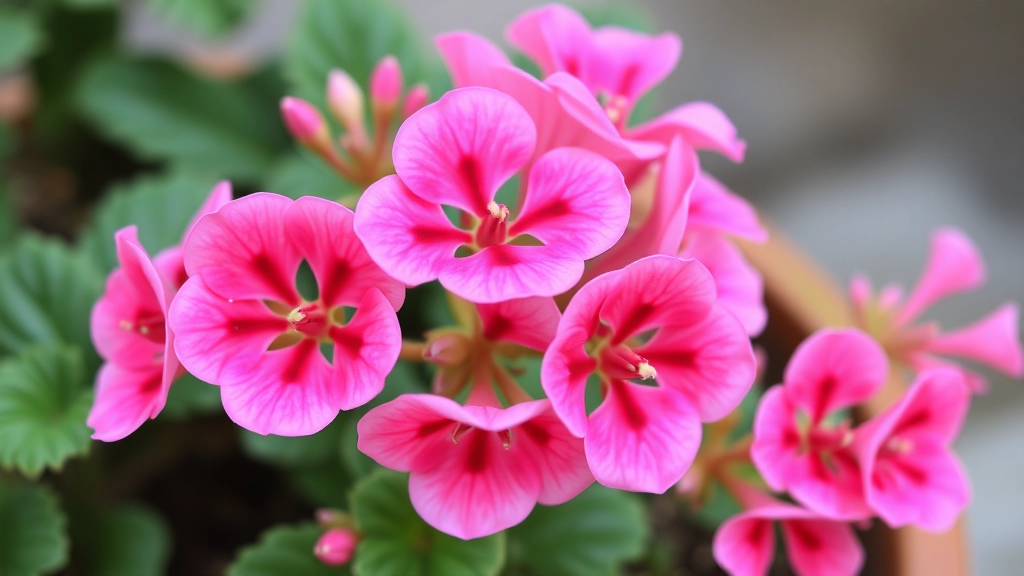The Pink Kalanchoe Plant
The Pink Kalanchoe Plant is a vibrant addition to any home or garden, offering a splash of colour with minimal fuss. Known for its stunning pink blooms and easy-care nature, this succulent is perfect for both novice and experienced gardeners. Whether you’re looking to brighten up your indoor space or add some charm to your outdoor garden, understanding the basics of Pink Kalanchoe care is essential.
Care Guide Overview
From selecting the right variety to mastering watering and light requirements, this guide covers everything you need to know. Learn about ideal growing conditions, how to prevent common pests, and tips for encouraging reblooming. With the right care, your Pink Kalanchoe Plant will thrive and bring joy year-round.
Overview of Pink Kalanchoe Varieties
When considering adding a splash of colour to your home or garden, Pink Kalanchoe varieties are a popular choice.
These vibrant succulents are not just visually appealing; they also offer a range of characteristics that cater to different preferences and growing conditions.
Popular Pink Kalanchoe Varieties
-
Kalanchoe blossfeldiana
- Known for its stunning clusters of pink flowers.
- Compact growth, making it ideal for small spaces. For more details, check out the ultimate guide to Kalanchoe blossfeldiana hybrid care.
-
Kalanchoe luciae (Paddle Plant)
- Features large, paddle-shaped leaves with a pinkish hue.
- A striking addition to any succulent collection. Learn more in the Kalanchoe paddle plant care guide.
-
Kalanchoe thyrsiflora
- Produces beautiful pink blooms and has a unique leaf shape.
- Grows well in both indoor and outdoor settings.
-
Kalanchoe ‘Pink Butterflies’
- Delicate pink flowers resembling butterflies.
- Great for attracting pollinators to your garden.
Why Choose Pink Kalanchoe?
- Versatility: These varieties can thrive in various environments, whether indoors or outdoors.
- Low Maintenance: Perfect for beginners or those with a busy lifestyle.
- Long Blooming Period: Enjoy vibrant blooms for extended periods, adding beauty to your space.
Ideal Growing Conditions for Pink Kalanchoe
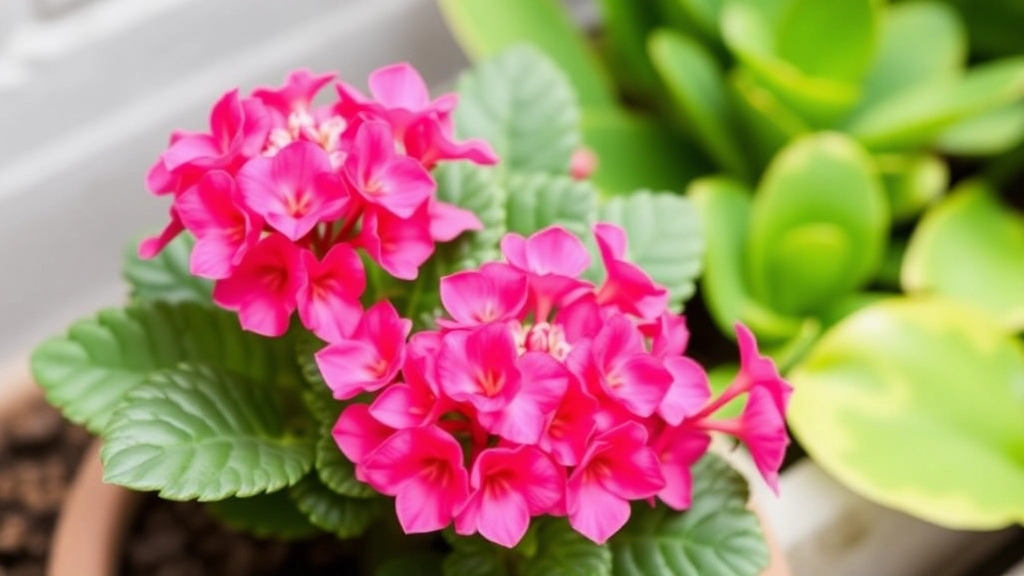
So, you’ve got your eye on that gorgeous Pink Kalanchoe and want to give it the best chance to thrive?
Let’s dive into the ideal growing conditions that will make your plant flourish.
Temperature
- Warmth is Key: Pink Kalanchoe loves a warm environment. Aim for temperatures between 15°C to 25°C (59°F to 77°F).
- Avoid the Chill: Keep it away from drafts or cold windows. They’re not fans of frost!
Humidity
- Moderate Humidity: These plants prefer moderate humidity levels. If your home is too dry, consider using a pebble tray or humidifier.
- Air Circulation: Good air circulation helps prevent mold and pests, so don’t crowd them with other plants.
Location
- Bright Spots: Place your Pink Kalanchoe in a location with plenty of indirect sunlight. A south-facing window is often perfect.
- Avoid Direct Sunlight: Too much direct sun can scorch those beautiful leaves.
Indoor vs. Outdoor
- Indoor: If you’re keeping it indoors, ensure it’s in a well-lit room.
- Outdoor: If you’re taking it outside, choose a spot with filtered light, especially in the hotter months.
Potting
- Well-Draining Pot: Use a pot with drainage holes to prevent waterlogging.
- Size Matters: Don’t go for a pot that’s too big; it can hold excess moisture.
Watering Tips for Healthy Growth
When it comes to caring for your Pink Kalanchoe, one of the most frequent concerns is watering. Many plant enthusiasts wonder: How much water is too much? Or, am I letting my plant dry out too often?
Understanding Watering Needs
Pink Kalanchoe is a succulent, which means it stores water in its leaves. This unique trait allows it to thrive in drier conditions, but it also means that overwatering can be detrimental. Here are some key tips for ensuring your Kalanchoe remains healthy:
- Check the Soil: Always assess the soil’s moisture level before watering. Stick your finger about an inch into the soil; if it feels dry, it’s time to water. If it’s still moist, hold off for a few days.
- Water Thoroughly: When you do water, ensure that you give your plant a good soak. Water should flow out of the drainage holes at the bottom of the pot. This ensures that the roots are receiving adequate moisture.
- Frequency: During the growing season (spring and summer), you may need to water every 1-2 weeks. In the dormant season (fall and winter), reduce watering to once every 2-3 weeks.
- Use Room Temperature Water: Cold water can shock the plant. Room temperature water is ideal for maintaining healthy growth.
- Avoid Water on Leaves: When watering, focus on the soil. Water on the leaves can lead to rot and fungal issues.
Signs of Watering Issues
Recognising the signs of overwatering or underwatering can save your plant from distress:
Light Requirements for Optimal Blooms
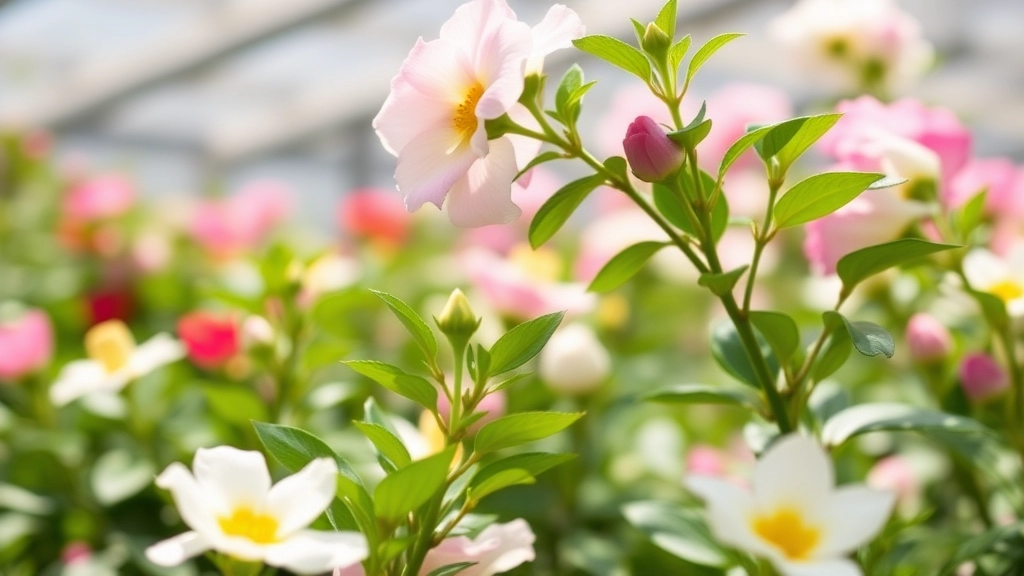
When it comes to nurturing your Pink Kalanchoe, understanding its light requirements is crucial for achieving those vibrant blooms.
Are you struggling to get your Kalanchoe to flower?
This succulent thrives best in bright, indirect sunlight. Here’s what you need to know:
- Ideal Light Conditions:
- Place your Pink Kalanchoe in a location where it receives 4 to 6 hours of bright, indirect light each day.
- A south-facing window is often the best spot, but be cautious of direct sunlight, which can scorch the leaves.
- Signs of Proper Lighting:
- Healthy, vibrant leaves indicate your plant is getting the right amount of light.
- If the leaves start stretching towards the light source, your Kalanchoe may be seeking more light.
- Adjusting Light Levels:
- If you notice leggy growth, consider moving your plant closer to the light.
- Conversely, if the leaves start to burn, you might need to provide some shade.
- Seasonal Changes:
- During winter months, the light intensity decreases. You may need to rotate your plant or supplement with grow lights to ensure it receives adequate light.
Soil Types and Drainage Needs
When it comes to growing Pink Kalanchoe, the right soil is crucial for their health and vibrancy.
Many plant enthusiasts often wonder, âWhat type of soil is best for my Pink Kalanchoe?â
Common Pests and How to Prevent Them
Have you ever noticed tiny critters on your Pink Kalanchoe?
It can be a real worry when pests invade your beloved plants.
But don’t fret!
Here’s a quick rundown on the common pests that might try to crash your plant party and how to keep them at bay.
Common Pests to Watch Out For
- Aphids – These little green or black bugs suck the sap from your plant, causing leaves to curl and yellow.
- Mealybugs – Look for white, cottony masses on stems and leaves. They can weaken your plant significantly.
- Spider Mites – Tiny and often overlooked, these pests leave fine webs and cause speckled leaves.
- Scale Insects – They appear as small, brown bumps on stems and leaves. They’re sneaky and can be tough to spot.
Prevention Tips
Keeping your Pink Kalanchoe healthy is your best defense against pests. Here’s how:
- Regular Inspections – Check your plants weekly for any signs of pests. Catching them early makes a huge difference.
- Maintain Good Air Circulation – Avoid overcrowding your plants. Good airflow helps deter pests.
- Water Wisely – Don’t overwater! Damp conditions attract pests.
- Use Neem Oil – A natural pesticide, neem oil is great for keeping pests away. Just mix it with water and spray it on your plants.
- Keep the Area Clean – Remove dead leaves and debris around your plant to reduce hiding spots for pests.
What to Do If You Spot Pests
If you do find pests, don’t panic! Here’s a quick action plan:
- Isolate Affected Plants – Move the infested plant away from others to prevent spreading.
- Wipe Them Off – Use a damp cloth or cotton swab to remove pests by hand.
- Insecticidal Soap – Spray with insecticidal soap for a more serious infestation.
Propagation Techniques for Pink Kalanchoe
After understanding the ideal conditions for nurturing your Pink Kalanchoe, you may wonder how to multiply these stunning plants. Propagation is an exciting way to expand your collection or share with friends.
Fertilizing Your Pink Kalanchoe for Best Results
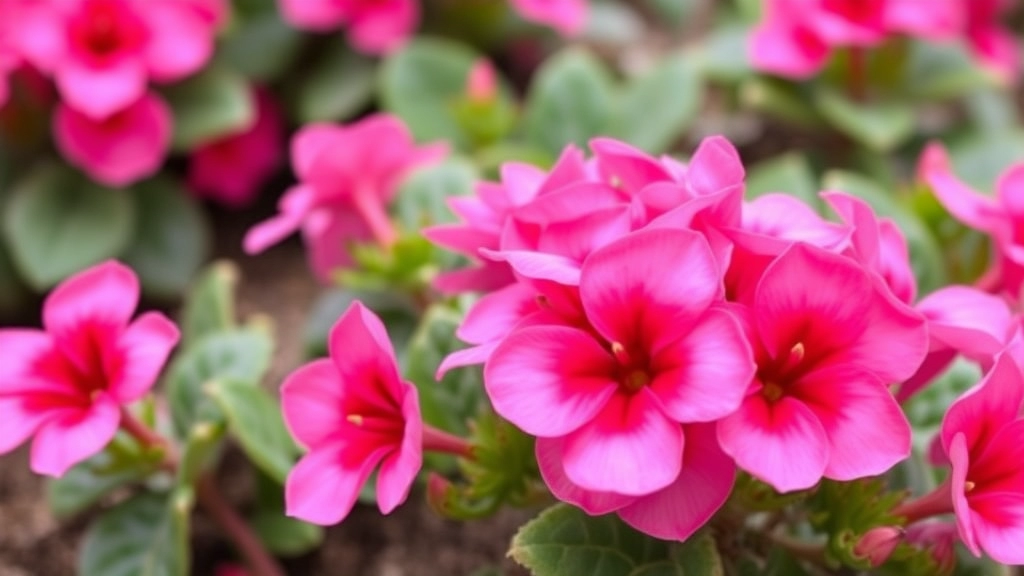
So, you’ve got your Pink Kalanchoe thriving, but how do you make sure it’s at its best? Fertilizing is a crucial part of keeping your plant vibrant and blooming beautifully.
When to Fertilize
- Growing Season: The best time to fertilize is during the growing season, typically spring and summer.
- Frequency: Aim for every 4-6 weeks to give your plant that extra boost.
What to Use
- Balanced Fertilizer: A balanced, water-soluble fertilizer works wonders. Look for a ratio like 10-10-10 or 20-20-20.
- Dilution: Always dilute it to half the recommended strength. Less is often more!
How to Apply
- Watering First: Water your Kalanchoe a day before you fertilize. This helps the roots absorb nutrients better.
- Application Method: Mix the fertilizer in water and pour it around the base of the plant, avoiding the leaves.
Signs of Nutrient Deficiency
- Yellowing Leaves: If you notice leaves turning yellow, it might be time to check your fertilizing routine.
- Stunted Growth: A lack of blooms or slow growth can signal that your Kalanchoe needs a nutrient boost.
How to Encourage Reblooming
After nurturing your Pink Kalanchoe through its initial blooming phase, you might find yourself wondering how to coax those vibrant flowers back to life.
Understanding Reblooming Needs
Reblooming can be a challenge, but with the right care, your Kalanchoe can flourish again. Here are some essential tips to encourage those beautiful blooms:
- Prune After Flowering: Once the flowers fade, trim back the spent blooms and any leggy growth. This helps redirect energy towards new growth and blooms.
- Adjust Watering: Reduce watering slightly after the blooming period. This allows the plant to rest and prepares it for the next flowering cycle.
- Provide a Dormancy Period: Allow your Kalanchoe a rest period of about six weeks. During this time, keep it in a cooler location and withhold fertiliser.
- Reintroduce Light: After the dormancy period, place your Kalanchoe back in a bright, indirect light spot. This will signal the plant that it’s time to bloom again.
- Fertilise Wisely: Once you see new growth, resume fertilising with a balanced, water-soluble fertiliser every two weeks. This provides the necessary nutrients for blooming.
- Ensure Proper Temperature: Maintain temperatures between 15-20°C (59-68°F) during the day and slightly cooler at night. This fluctuation can encourage flowering.
By following these steps, you can create an environment that encourages your Pink Kalanchoe to bloom again, bringing joy to your space. For more detailed guidance, check out our Ultimate Guide to Growing Kalanchoe Pink Flowers. Additionally, understanding the Ideal Temperature for Kalanchoe Blossfeldiana Growth can further enhance your plant’s blooming potential.
Signs of Overwatering and Underwatering Your Pink Kalanchoe
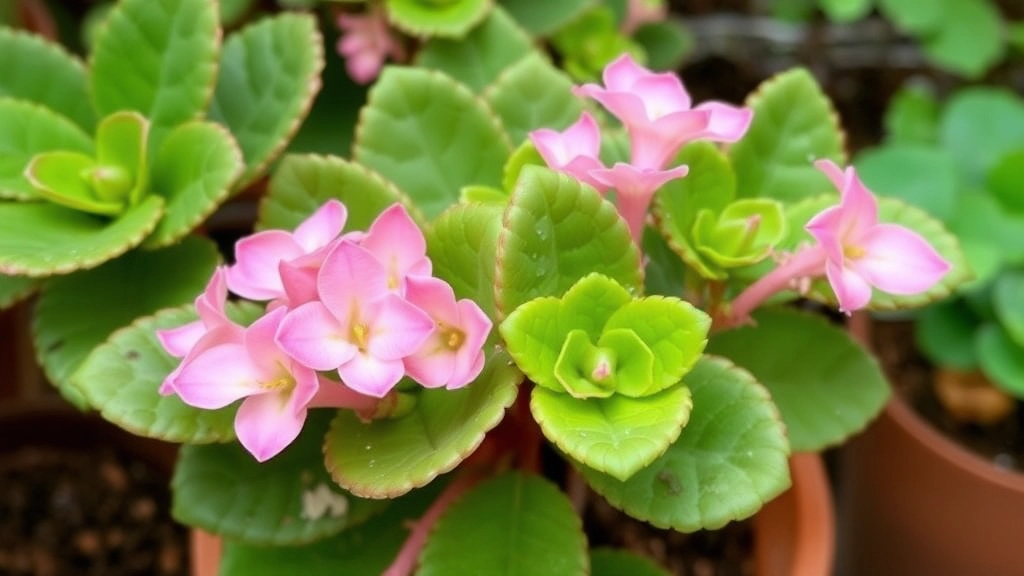
So, you’ve got your Pink Kalanchoe, and you’re doing your best to keep it thriving. But how do you know if you’re giving it too much love—or not enough?
Overwatering Signs:
- Yellow Leaves: If those vibrant green leaves start turning yellow, it’s a big red flag.
- Soft, Mushy Stems: Healthy stems should feel firm. If they’re squishy, you might be drowning your plant.
- Root Rot: If you pull the plant out and see dark, mushy roots, it’s time to reassess your watering routine.
- Fungal Growth: Any white or fuzzy patches on the soil? That’s a sign of overwatering leading to mold.
Underwatering Signs:
- Crispy Leaves: If the leaves feel dry and crunchy, your plant is thirsty.
- Drooping: A wilted appearance is a cry for help—your Kalanchoe needs a drink.
- Leaf Drop: If leaves start falling off, it’s a sign the plant is stressed from lack of water.
- Shriveled Leaves: When leaves look shriveled or shrunk, it’s time to hydrate.
Quick Tips:
- Check the Soil: Stick your finger about an inch into the soil. If it’s dry, water it. If it’s wet, hold off.
- Watering Schedule: Aim for every 2-3 weeks, but adjust based on your home’s humidity and temperature.
- Pot Drainage: Make sure your pot has drainage holes. This helps prevent water from sitting at the bottom.
Choosing the Right Pot and Repotting Tips
Selecting the right pot for your Pink Kalanchoe is crucial for its overall health and growth. You might be wondering, “What size pot should I use?” or “When is the best time to repot?” These are common concerns for any plant enthusiast.
Pot Size and Material
- Size: Choose a pot that is slightly larger than the current one. A pot that is about 2-4 inches wider in diameter is ideal. This allows room for root growth without overwhelming the plant.
- Material: Terracotta pots are excellent for Kalanchoe as they provide good aeration and drainage. Plastic pots can also work, but ensure they have drainage holes.
Drainage is Key
- Always opt for pots with drainage holes.
- Excess water can lead to root rot, which is detrimental to your Kalanchoe.
Repotting Tips
- Timing: The best time to repot is during the spring, just before the growing season begins.
- Soil: Use a well-draining soil mix, ideally one designed for succulents or cacti.
- Gentle Handling: When repotting, handle the roots gently to avoid damage. Shake off excess soil and inspect for any signs of rot.
Signs Your Kalanchoe Needs Repotting
- Roots are growing out of the drainage holes.
- The plant appears top-heavy or unstable.
- Soil dries out too quickly.
By ensuring you have the right pot and following these repotting tips, you can help your Pink Kalanchoe thrive. For a more detailed guide on how to plant Kalanchoe in a pot, check out our step-by-step guide. Additionally, if you’re interested in learning more about the different varieties and care tips for Kalanchoe, our comprehensive species list is a great resource.
Ever wondered how to keep your Pink Kalanchoe thriving through the seasons?
Let’s dive into the seasonal care and temperature guidelines that will help you maintain vibrant blooms, whether indoors or outdoors.
### Indoor Growth
#### Temperature
– **Ideal Range:** Keep your Pink Kalanchoe in a cozy spot between **15°C to 25°C**.
– **Avoid Extremes:** Sudden temperature drops or drafts can stress your plant.
#### Seasonal Care
– **Spring/Summer:**
– Water more frequently as the plant actively grows.
– Fertilize every month to boost growth.
– **Autumn/Winter:**
– Cut back on watering; the plant needs less moisture.
– Reduce fertilization to every two months.
### Outdoor Growth
#### Temperature
– **Warmth is Key:** Pink Kalanchoe loves warmth, so aim for **20°C to 30°C** during the day.
– **Night Chill:** Protect from frost; if temperatures drop below **10°C**, bring them indoors.
#### Seasonal Care
– **Spring/Summer:**
– Water regularly, ensuring the soil dries out between sessions.
– Fertilize every 4-6 weeks to encourage those stunning blooms.
– **Autumn/Winter:**
– Water less frequently, as the plant goes dormant.
– If you live in a cooler climate, consider bringing your Kalanchoe inside before the first frost.
#### Quick Tips
– **Humidity:** Pink Kalanchoe prefers low humidity. Avoid overly humid areas.
– **Sun Exposure:** Ensure they get plenty of bright, indirect sunlight, especially in the spring and summer.
For more detailed care instructions, you might want to check out the [ultimate guide to growing and caring for succulent plant Kalanchoe](https://planthq.org/ultimate-guide-to-growing-and-caring-for-succulent-plant-kalanchoe/) and the [complete guide to growing Kalanchoe Pink Plant](https://planthq.org/ultimate-guide-to-growing-kalanchoe-pink-plant/).
FAQs about Pink Kalanchoe Plant
What are the ideal growing conditions for a Pink Kalanchoe?
The ideal growing conditions include temperatures between 15°C to 25°C (59°F to 77°F), moderate humidity, and plenty of indirect sunlight. Avoid drafts, cold windows, and direct sunlight to prevent damage to the plant.
How much light does a Pink Kalanchoe need?
Your Pink Kalanchoe thrives best with 4 to 6 hours of bright, indirect light daily. A south-facing window is often ideal, but be cautious of direct sunlight, which can scorch the leaves.
Can I keep my Pink Kalanchoe outdoors?
Yes, you can keep it outdoors in a spot with filtered light, especially during the hotter months. Ensure the plant is not exposed to direct sunlight for prolonged periods.
What type of pot is best for a Pink Kalanchoe?
Use a well-draining pot with drainage holes to prevent waterlogging. Avoid using a pot that’s too big, as it can hold excess moisture.
How often should I fertilize my Pink Kalanchoe?
Fertilize your Pink Kalanchoe every 4-6 weeks during the growing season (spring and summer) using a balanced, water-soluble fertilizer diluted to half the recommended strength.
What are the common pests that affect Pink Kalanchoe, and how can I prevent them?
Common pests include aphids, mealybugs, spider mites, and scale insects. Prevent pests by regularly inspecting your plant, maintaining good air circulation, watering wisely, using neem oil, and keeping the area clean.
What should I do if I find pests on my Pink Kalanchoe?
If you spot pests, isolate the affected plant, wipe off the pests with a damp cloth, and use insecticidal soap for more serious infestations.
What are the signs of overwatering my Pink Kalanchoe?
Signs of overwatering include yellow leaves, soft and mushy stems, root rot, and fungal growth. Ensure your pot has drainage holes and adjust your watering schedule accordingly.
How can I tell if my Pink Kalanchoe is underwatered?
Signs of underwatering include crispy leaves, drooping, leaf drop, and shriveled leaves. Check the soil moisture and adjust your watering schedule to every 2-3 weeks, depending on your home’s humidity and temperature.
How do I ensure my Pink Kalanchoe blooms optimally?
To achieve vibrant blooms, provide 4 to 6 hours of bright, indirect light daily, and consider using grow lights during winter months when light intensity decreases. Healthy, vibrant leaves indicate proper lighting conditions.
References
-
How to Grow Kalanchoe Plants
-
Kalanchoe Plant Care â How To Grow A Kalanchoe
-
Kalanchoe: Plant Care & Growing Guide
